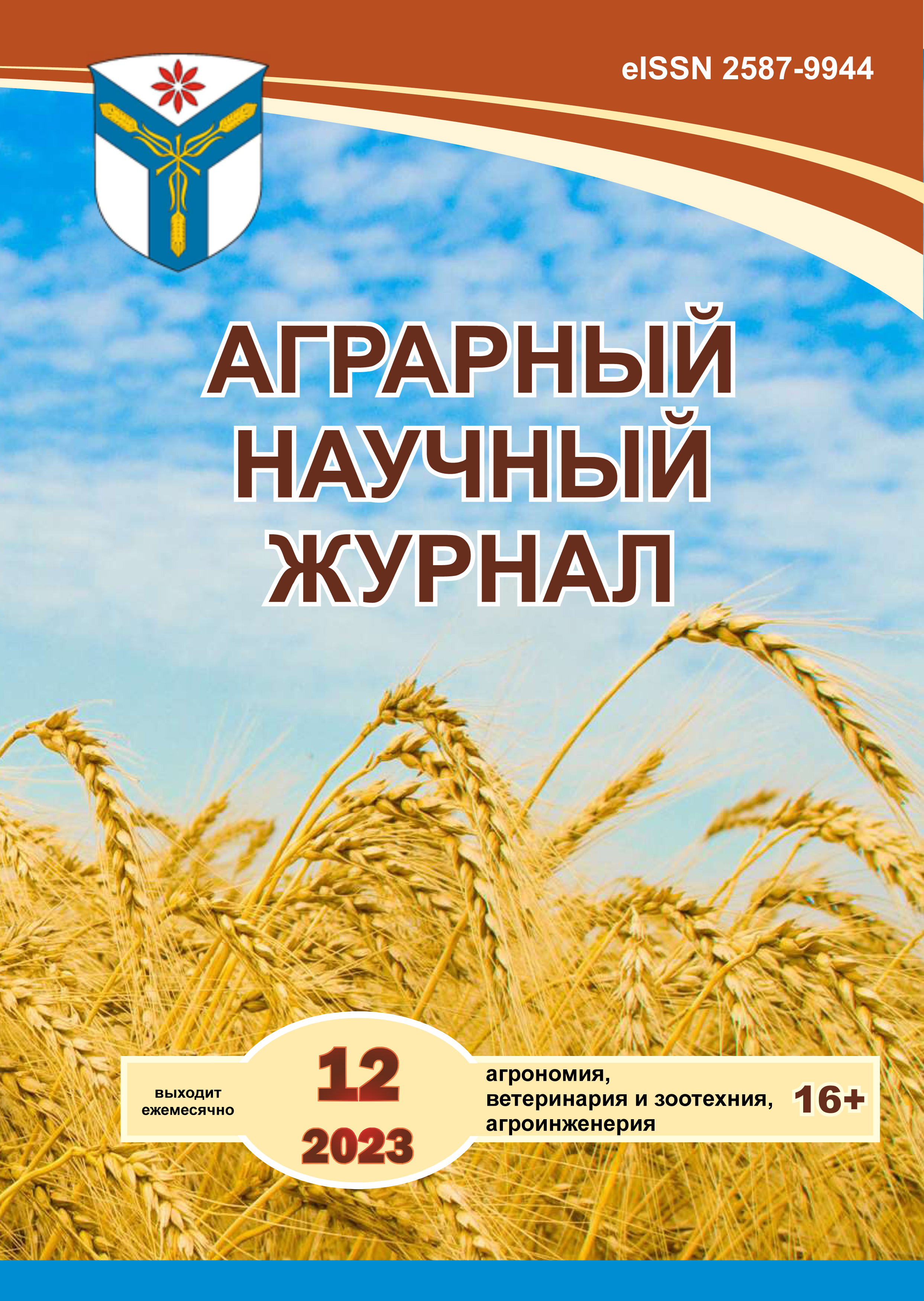The content of somatic cells in goat milk during the breeding and nonbreeding seasons
DOI:
https://doi.org/10.28983/asj.y2023i12pp106-110Keywords:
Saanen breed, somatic cells, lactose, milk yieldAbstract
The somatic cell count (SCC) is considered to be an indirect indicator of the hygienic quality of milk, but the content of somatic cells in goat milk may be due to a number of factors unrelated to intramammary infection. The purpose of our study was to determine the SCC for 5-26 weeks of lactation in Saanen goats of the second lactation in connection with milk yield, the mass fraction of lactose in milk (MFL) and taking into account the breeding season. The analyzed group was formed from 22 females of spring lambing (April). The results of our study showed that at 5-18 weeks lactation, before the start of the breeding period, the dynamics of SCC as a whole was similar to the change in daily milk yield (DA). From 17-18 weeks. up to 21-22 weeks and further up to 25-26 weeks DA decreased by 1.2-1.3 times (p<0.01 and p<0.001). But SCC for 21-22 weeks of lactation (peak breeding season) increased by 1.7 times (p<0.01) and significantly exceeded 1000 ? 103 units/ml. At 25-26 weeks of lactation, a decrease in SCC by 1.4 times (p<0.05) was found out, but on average the content of somatic cells remained at the level of 1000 ? 103 units/ml. The lactose content had a negative trend throughout lactation, and no correlation was found out between MFL and SCC. We assume that the increase in SCC in the last months of lactation is a consequence of changes in the hormonal background in the breeding season.
Downloads
References
Влияние количества соматических клеток с учетом их морфологической дифференциации на компонентный состав молока коров / М. В. Позовникова [и др.] // Российская сельскохозяйственная наука. 2022. № 6. С. 57–62. DOI: 10.31857/S2500262722060114.
Межгосударственный стандарт-ГОСТ 32940-2014. «Молоко козье, сырое. Технические условия». М.: Стандартинформ, 2018.
Морфологический состав соматических клеток в молоке коров как критерий оценки здоровья молочной железы в связи с продуктивностью и компонентами молока / А. А. Сермягин [и др.] // Сельскохозяйственная биология. 2021. Т. 56. № 6. С. 1183–1198. DOI: 10.15389/agrobiology.2021.6.1183rus.
Новопашина С. И., Санников М. Ю., Кизилова Е. И. Содержание соматических клеток в молоке зааненских коз в зависимости от возраста и сезонов года // Сельскохозяйственный журнал. 2013. Т. 1. № 6. С. 163–165. URL: https://cyberleninka.ru/article/n/soderzhanie-somaticheskih-kletok-v-moloke-zaanenskih-koz-v-zavisimosti-ot-vozrasta-i-sezonov-goda (дата обращения: 21.01.2023).
Milk lactose as a biomarker of subclinical mastitis in dairy cows / R. Antanaitis et al. // Animals. 2021. 11(6). Р. 1736. DOI:10.3390/ani11061736.
Bovine fetal mesenchymal stem cells exert antiproliferative effect against mastitis causing pathogen Staphylococcus aureus / B. Cahuascanco et al. // Veterinary research. 2019. N. 50. P. 1–10. DOI: 10.1186/s13567-019-0643-1.
Haenlein G. F.W. Relationship of somatic cell counts in goat milk to mastitis and productivity // Small Ruminant Research. 2002. Vol. 45(2). P. 163–178. DOI: 10.1016/S0921-4488(02)00097-4.
Kuwahara K., Yoshimura Y., Isobe, N. Effect of steroid hormones on the innate immune response induced by Staphylococcus aureus in the goat mammary gland // Reproduction in Domestic Animals. 2017. Vol. 52(4). P. 579–584. DOI:10.1111/rda.12948.
Influence of Estrus of Dairy Goats on Somatic Cell Count, Milk Traits, and Sex Steroid Receptors in the Mammary Gland / P. Moroni et al. // Journal of Dairy Science. 2007. Vol. 90(2). P. 790–797. DOI: 10.3168/jds.S0022-0302(07)71563-1.
Novac C. S., Andrei S. The Impact of mastitis on the biochemical parameters, oxidative and nitrosative stress markers in goat’s milk: A review // Pathogens. 2020. Vol. 9(11). P. 882. DOI: 10.3390/pathogens9110882.
Ordinance (Includes provisions from the Grade “A” Condensed and Dry Milk Products and Condensed and Dry Whey--Supplement I to the Grade “A” PMO) 2019. Revision U.S. Department of Health and Human Services Public Health Service Food and Drug Administration. P. 447. URL:https://www.fda.gov/media/140394/download (дата обращения: 21.01.2023).
Milk somatic cells and lactation in small ruminants / M. J. Paape et al. // Journal of Dairy Science. 2001. Vol. 84. P. 237–244. DOI: 10.3168/jds.S0022-0302(01)70223-8.
Somatic cell count in goat milk: an indirect quality indicator / K. Podhorecka et al. // Foods. 2021. Vol. 10(5). P. 1046. DOI: 10.3390/foods10051046.
Raynal-Ljutovac K., Gaborit P., Lauret A. The relationship between quality criteria of goat milk, its technological properties and the quality of the final products // Small Rumin. Res. 2005. Vol. 60. P. 167–177. DOI: 10.1016/j.smallrumres.2005.06.010.
Subclinical mastitis in goats is associated with upregulation of nitric oxidederived oxidative stress that causes reduction of milk antioxidative properties and impairment of its quality / N. Silanikove et al. // Journal of Dairy Science. 2014. Vol. 97. P. 3449–3455. DOI: 10.3168/jds.2013-7334.
Distribution of somatic cell count and udder pathogens in Norwegian dairy goats / M. N. Smistad et al. // Journal of Dairy Science. 2021. Vol. 104(11). P. 11878–11888. DOI: 10.3168/jds.2021-20549.
The concentration of free fatty acids in goat milk as related to the stage of lactation, age and somatic cell count / N. Strza?kowska et al. // Animal Science Papers and Reports. 2010. Vol. 28(4). P. 389–395.
Ying C., Wang H. T., Hsu J. T. Relationship of somatic cell count, physical, chemical and enzymatic properties to the bacterial standard plate count in dairy goat milk // Livestock Production Science. 2022. Vol. 74(1). P 63–77. DOI: 10.1016/S0301-6226(01)00290.
Effects of month of kidding, parity number, and litter size on milk yield of commercial dairy goats in Australia / F. Zamuner et al. // Journal of Dairy Science. 2020. Vol. 103(1). P. 954–964. DOI: 10.3168/jds.2019-17051.
Downloads
Published
Issue
Section
License
Copyright (c) 2023 The Agrarian Scientific Journal

This work is licensed under a Creative Commons Attribution-NonCommercial-NoDerivatives 4.0 International License.








